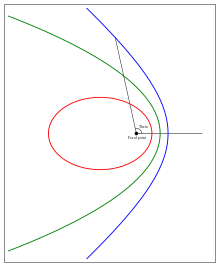Eccentricity (astronomy)

Green: Parabolic Kepler orbit with eccentricity 1
Blue: hyperbolic Kepler orbit with eccentricity 1.3
In astronomy, eccentricity is a characteristic quantity for the orbit of a celestial body ; it is one of its pathways . It is usually used as a quantity related to another path element, i.e. as a numerical eccentricity . For example, in the case of an elliptical orbit, it is related to its major semi-axis .
In astronomy, therefore, one does not usually speak of "numerical eccentricity", but only of "eccentricity" and uses the symbol for this . Since the latter is used in mathematics for the linear eccentricity (for the numerical eccentricity there ), there is a risk of confusion.
Possible values
The eccentricity, a dimensionless number, can have the following values:
- 0 for exactly circular paths.
- between 0 and 1 for elliptical orbits (where values close to 0 characterize orbits similar to a circle, and the ellipse appears more elongated the closer the eccentricity is to 1).
- 1 for exactly parabolic orbits.
- greater than 1 for hyperbolic orbits (the greater the value, the more open the hyperbola).
While values below 1 describe closed orbits (i.e. orbits ), values from 1 refer to open orbits that are only run through once.
Connection with other web properties
For an orbit in the form of an ellipse the following applies:
- Periapsis distance = major semi-axis times (1 - eccentricity):
- Apoapsis distance = major semi-axis times (1 + eccentricity):
Eccentricity angle
The eccentricity angle α is a path element derived from the eccentricity e :
It is the angle between the focal point (F) and the center point (O) as seen from the side vertex (B) (see adjacent figure).
Eccentricities of some orbits
Of the orbits of the planets in the solar system , the orbit of Venus has the smallest eccentricity at 0.0068 (is therefore the most circular) and the orbit of Mercury has the largest at 0.2056. The eccentricity of the earth's orbit is 0.0167. The values for the other planetary orbits can be found in the list of planets in the solar system .
The orbits of some Trans-Neptunian objects show significantly greater eccentricity : Pluto with 0.2502, Eris with 0.4383 and Sedna with 0.8587.
Comet orbits generally have very different eccentricity values. In (short-) periodic comets the eccentricity is usually between 0.2 and 0.7, although there are some that have very highly eccentric elliptical orbits, for example Comet Halley has an eccentricity of 0.967. In almost all non-periodic or long-period comets with an orbital period of more than 200 years, the value is only slightly below 1, so comet 153P / Ikeya-Zhang has an orbital eccentricity of 0.990 with an orbital period of around 366 years.
The asteroid 1I / ʻOumuamua comes from interstellar space and moves on a hyperbolic orbit through the solar system. Its eccentricity of 1.1995 is thus clearly greater than 1. The comet C / 1980 E1 (Bowell) comes from the solar system, but was by a close passage to Jupiter deflected to a hyperbolic path having an eccentricity of 1.0577 and is the Leaving solar system. The comet 2I / Borisov discovered in August 2019 has a significantly higher eccentricity of around 3.4 and is the second interstellar object discovered in the solar system.
See also
Individual evidence
- ^ John S. Lewis : Physics and Chemistry of the Solar System . Academic Press, San Diego CA et al. a. 1995, ISBN 0-12-446740-7 (English, online [accessed March 29, 2015]).
- ↑ 'Oumuamua (A / 2017 U1). In: JPL Small-Body Database Browser. Retrieved December 2, 2017 .
- ↑ Michael F. Ahearn, DGSchleicher, RLMillis, PDFeldman, DT Thompson: Comet Bowell 1980b . In: Astronomical Journal . No. 89 , 1984, pp. 579-591 , doi : 10.1086 / 113552 , bibcode : 1984AJ ..... 89..579A .
- ↑ JPL Small-Body Database Browser: C / 1980 E1 (Bowell)
- ↑ MPEC 2019-S72: 2I / Borisov = C / 2019 Q4 (Borisov). In: Minor Planet Center. September 24, 2019, accessed on September 24, 2019 .






